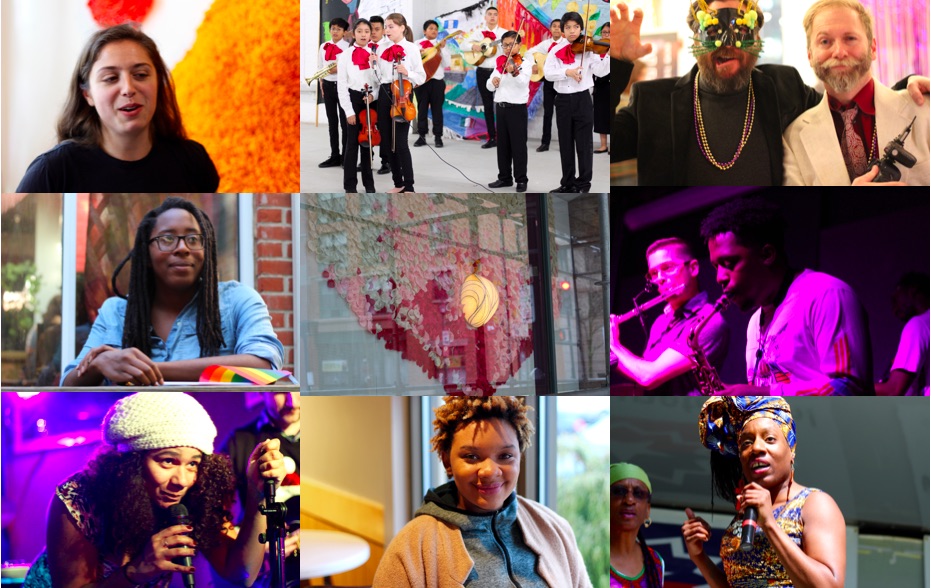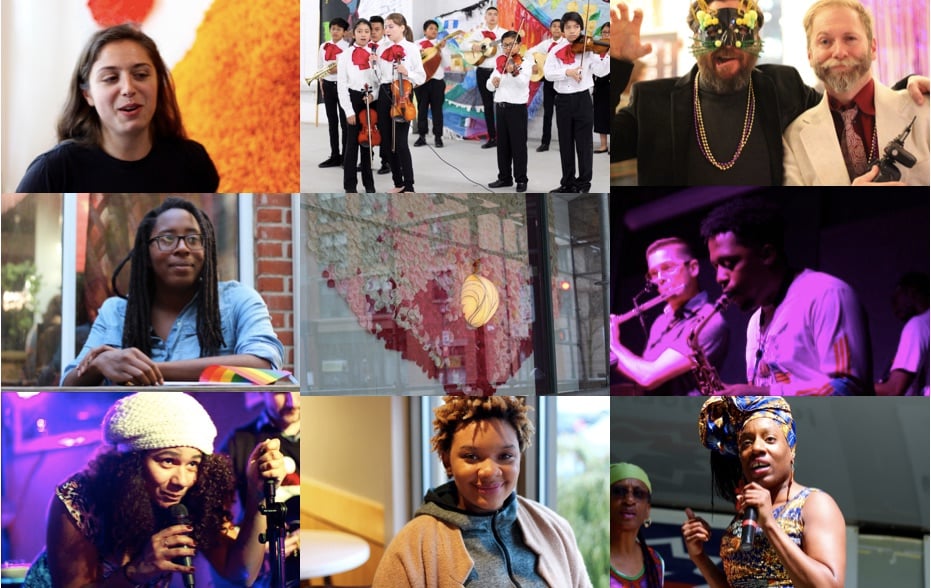
Culture & Community | Arts & Culture | COVID-19
 Top row: Artist Molly Gambardella, Mariachi Academy of New England students, Lou Mangini with Photographer Johnathon Henninger. Middle Row: Amira Brown, artwork by Althea Rao, musician Stephen Gritz King. Bottom row: Musician Fernanda Franco, Teaching artist and West Haven Council Member Trenée McGee, and Hanan Hameen. They are among the first 146 recipients.
Top row: Artist Molly Gambardella, Mariachi Academy of New England students, Lou Mangini with Photographer Johnathon Henninger. Middle Row: Amira Brown, artwork by Althea Rao, musician Stephen Gritz King. Bottom row: Musician Fernanda Franco, Teaching artist and West Haven Council Member Trenée McGee, and Hanan Hameen. They are among the first 146 recipients. Two weeks after launching, the New Haven Creative Sector Relief Fund has announced a first round of funding to both individual artists and small-budget arts sector organizations. In all, $65,000 has been distributed among 146 recipients, in amounts ranging from $250 to $500.
The Arts Council of Greater New Haven made that announcement Thursday, in an email to its members that also included COVID-19 funding resources at the state and national levels. Fundraising efforts, including a call for community donations, are continuing online.
The fund is a collaboration between the Arts Council and the city's Division of Arts, Culture & Tourism. At the time of its launch in late March, it held $60,000—$50,000 from the division’s not-for-profit arm New Haven Festivals, Inc. and $10,000 from the Arts Council’s Artist Next Door Fund.
An additional $5,000 came from a Facebook fundraiser than Arts Council Executive Director Daniel Fitzmaurice held for his March 26 birthday. (For full transparency, the Arts Paper is an arm of the Arts Council but is editorially independent from it).
Donations from community members have continued to come in online. It is not yet clear how much additional money the city and the Arts Council will put into the fund, applications and a waitlist for which have remained open.
Currently, funds have gone to practicing artists who meet the United Way’s ALICE (Asset Limited, Income Constrained, Employed) Stability threshold as well as arts organizations with a budget of less than $500,000 per year. When it launched, partners described it as open to “practicing artists of any discipline, teaching artists, and arts industry workers.”
The list of recipients, which range from singer-songwriters to photographers to dancers to barbershops, now reflects that broad lens on arts and culture. They are puppet artists and orchestras, theater collectives and gallery incubators that don't know when they'll see audience again.
Some organizations—Elm Shakespeare Company, Fresh Yoga, the Mariachi Academy of New England and Ice The Beef, for instance—have continued to work directly with people, despite the fact that they must now bridge the digital divide to do it.
Others, like New Haven Jazz Underground and Movimiento Cultural Afro-Continental, Inc., are using the money to seek out opportunities for area artists who may be out of work and build online programming.
Individual artists come from all disciplines, from musicians Stephen Gritz King, Alex Burnet, Chad Browne-Springer, Aaron Rodgers, Fernanda Franco and many others to visual artists Amira Brown, Christopher O’Flaherty, Daniel Pizarro, and Sara Zunda to style gurus at Best Choice Barbershop.
Almost all of them wrote in with the same story: their teaching work, second and sometimes third jobs, and shows had been cancelled. In hours, and sometimes days, they went from relative financial stability to zero dollars coming in.
Many of the applicants were parents; others noted that they were expecting children, raising children, or coping with a partner who had also been laid off. They painted 146 snapshots of the millions of Americans who have found themselves without work, and started to apply for unemployment and navigate what the $2.2 trillion CARES relief bill means for them.
Dancer Hanan Hameen, who teaches at Neighborhood Music School, saw months of workshops and residencies disappear. She is using the funding to meet her basic needs, including home equipment that is keeping her healthy from isolation.
As she moves her work online—including dance that now happens through a screen—she has spoken out about also fighting Lupus in the midst of a pandemic, as life-saving medications become harder to find.
"It [the funding] came in handy today as I needed to get groceries, meds, and medical supplies after being self-isolated for a month," she wrote in a message Friday morning.
Other recipients, like poet-organizer Dymin Ellis and dancer Alexis Robbins, suggested they could use the funding to both care for themselves and connect with creative collaborators in the city, despite the challenges that physical distancing may now pose.
Robbins said she will use the funding for grocery and insurance payments, and reinvest what was left over in her company, paying would-have-been collaborators.
Ellis said that in addition to utilities, they will be using the money to support online artistic work that's being done in the community. Originally, they had expected to serve as an AmeriCorps Public Allies member at Artspace New Haven through June. After COVID-19 closures hit the city, Artspace told Ellis that their term would be ending early.
"I meet with a group of emerging artists every week and plan a for virtual exhibition that responds to the pandemic," they wrote in an email. "We are artists from an array of disciplines looking ahead, making bold steps, and pursuing our ambitions. Personally, I can feel on a metaphysical level that a Renaissance has been triggered. I'm glad to be walking into this new era alongside a collaborative of young, creative visionaries and makers like myself."

